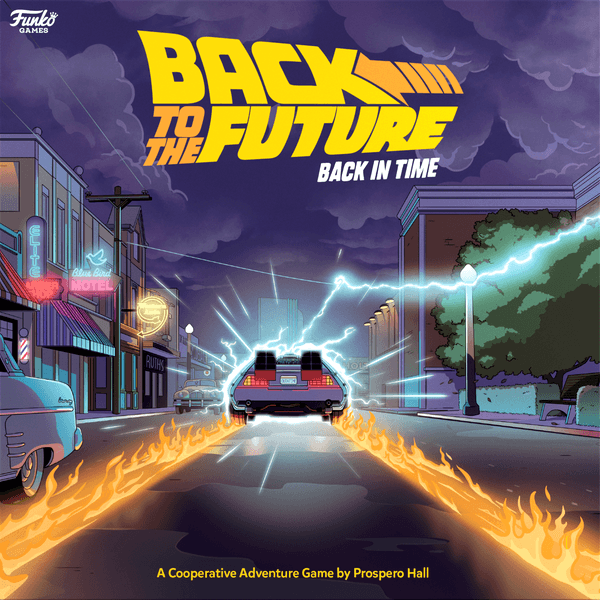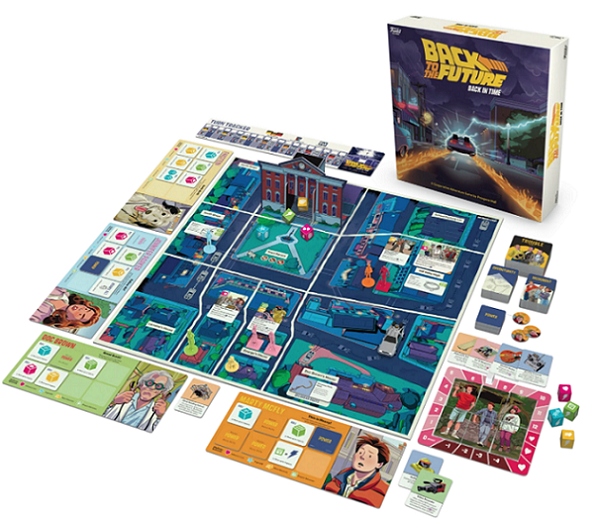Back to the Future: Back in Time Is a Cooperative Dice Rolling Adventure

Great Scott! Based on the popular 1985 film, Back to the Future: Back in Time has players trying to help Marty McFly’s parents fall in love, avoid the bully Biff, and get the time traveling DeLorean back on the road.
Designed by Prospero Hall (the minds behind Villainous and Horrified) and published by Funko Games, Back in Time is a cooperative dice game for two-to-four players. So how does the time traveling film translate into board game form?
Gameplay
The board is set in the middle of the table. The board shows ten locations, each representing a different location in town. The Biff, George, and Lorraine character figures are placed at their start locations on the board. Each player then chooses a character, each of whom comes with a unique ability. Each character also comes with their own unique set of five starting power tiles. Power tiles are used during the game to take actions.
In order to win the game, the players must have two goals completed during the final round of the game. Marty’s parents’ (George and Lorraine) love meter must be at least at a certain point, and the DeLorean must have reached a certain space on its own track on the board. Even if you had both conditions met earlier in the game, if they are not still true during the final round the players lose.
On a player’s turn, you move the turn tracker forward on the turn tracker board and trigger whatever action is shown. This can be: draw a trouble card, draw a movement card, check the love meter, or some combination of the three. When you draw a trouble card, you place it at the location shown on the card. Trouble cards will cause a negative effect that stays in play until the card is resolved. If the turn tracker has you check the love meter, you see if the track is in the required range for winning. If it is not, then you must flip one of the six photo tiles face-down (this represents Marty fading out of existence due to history being changed). If all six tiles are ever flipped, the players automatically lose the game. Finally, movement cards will move Loraine, George, and Biff around the board.
After moving and resolving the turn tracker, the active player then takes his turn. On your turn, you may use any of your power tiles up to one time each. Most power tiles can be used to move three spaces or add one or more dice to the number you roll for a challenge.
When moving, if you are on a space with George or Lorraine, you may take them with you at no extra movement cost. There are also a number of different challenge types, but they all operate the same way. Each will show at least one of three icons. Some challenges may ask for multiple icons. There are three types of dice in the game. Each die type favors one of three icons, has two Biff results, and two wilds. When you roll to complete a challenge, you must lock in any Biffs you roll. Then if you have rolled the icons the challenge requires, you win; otherwise you may choose to reroll any unlocked dice. You may continue to reroll until you choose to stop or all dice are locked. You must then resolve any Biffs you rolled. For each Biff you rolled, you move him one space closer to George or Lorraine (whoever is closer). Once he is on the same location as one or both, any more Biffs force the love meter to go down one space.
Challenge types include resolving trouble cards, influencing love (this may only be done if on the same space with both George and Lorraine, and the love meter goes up one point for each heart and wild you roll), move the DeLorean (this may only be done if you are on the same location as the DeLorean, and it moves forward one space on its track for each speed and wild you roll), prepare the DeLorean (there are three parts scattered around the board that you must move to and prepare; the DeLorean can only go so far along its track without these three parts), and fight Biff (one success knocks him down, and each subsequent success adds a knockdown token; next time a die or a movement card would trigger Biff, you instead discard a token for each Biff result until he is back on his feet and then continues as normal).
There are also always three opportunity cards on the board, each with its own challenge you can attempt. If you complete one you receive the reward shown on the card. Trouble cards will also often have rewards for completing them. Rewards can be items with special abilities you can use once per turn or letting you draw a power tile. Power tiles you draw are more powerful than your starting tiles (often letting you add more dice to your challenge roll and sometimes even allowing you to modify your rolls). You can only have eight power tiles at a time. If you draw more, you choose which ones to keep. If the active player is on a location with another player, the inactive player can spend their power tokens to help the active player with a challenge, rolling extra dice for them.

Review
Back to the Future: Back in Time nicely combines cooperative gameplay with dice mechanics. Players have lots of information on which to plan out future moves: you can see what is coming up on the turn tracker, you know where everything is on the board, and you can clearly see how close you are (or how far you are) to win conditions. This leads to lots of chances to discuss and debate best courses of action, while the luck of the roll and the uncertainty of how the movement cards or trouble cards will change the board between turns, keeps things unpredictable and exciting.
The fact that once you have accomplished both winning goals you still have to keep playing is a nice touch, too. We enjoyed this need to constantly keep maintaining things, as both the car can be set back and the love meter is always in danger from Biff. This keeps even the final rounds of the game suspenseful.
There is also an enjoyable evolution during the game. Certain characters start the game being slightly better at different challenge types based on their starting tiles, but the power tiles you draw are so important to what strengths your characters will evolve into. This means that halfway through the game you can easily find yourself changing your focus and swapping plans with other people. This also means that strategies are going to change from game to game depending on what power tiles you draw. However, all player information is public knowledge, so if you do have players in a group that tend to 'quarterback' (over-manage other players' turns) in cooperative games, there’s nothing really here to prevent that from happening.
Back in Time does a great job of adapting its source material into board game form. The artwork is all original while still making the characters look like their counterparts, and the DeLorean game piece is really fabulous looking. The picture tiles slowly being flipped is a great mechanism that ties in well with both the movie and the theme of trying to right history. The character boards, however, are not cardboard, only thick cardstock, and they were already a little bent when we took them out of the box.
As with many games based on licensed material, Back in Time is heavily steeped in the source material, so if you’re not a fan of the movie or you just haven’t seen it, you’re probably going to feel like you’re missing out on part of the enjoyment of the game. However, there is still plenty that's good with the gameplay itself, even if you’re not a Back to the Future fan.
You will win some and lose some in Back in Time, the difficulty is well balanced, with enough room for luck and some good strategizing. There are a number of rules to go through on initial learning, but they’re all fairly easy to remember, and once we went through the rulebook once, we didn’t find we repeatedly had to go back and recheck things. It’s suspenseful and enjoyable, and with plenty of options every turn.
Pros: Many options each turn, suspenseful end game, quite thematic
Cons: It is very tied in with its theme, potential for 'quarterbacking', character boards are thin and easily bent












